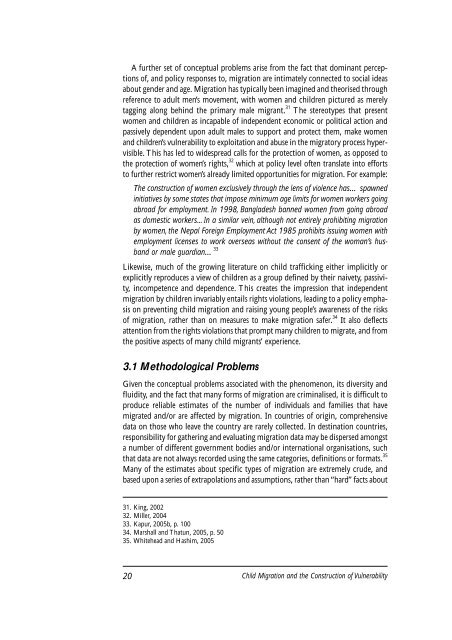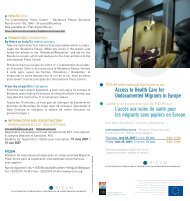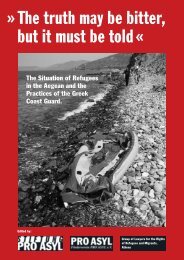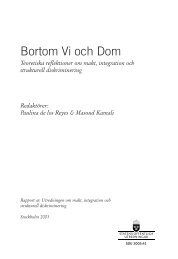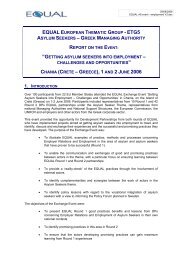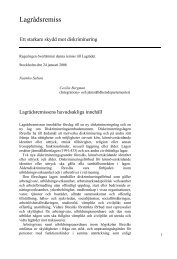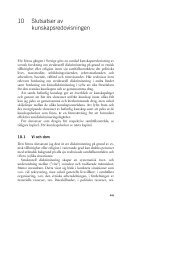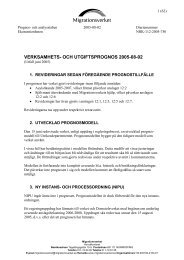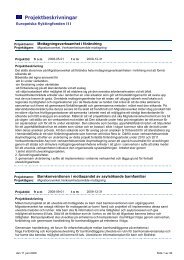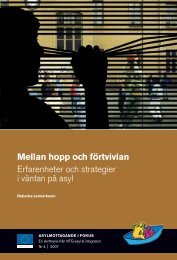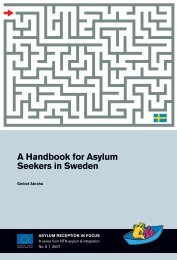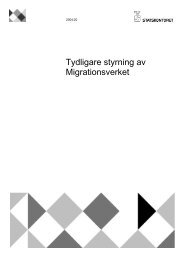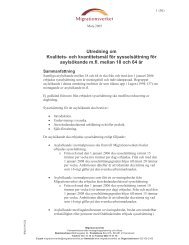and the Construction of Vulnerability - Child Trafficking
and the Construction of Vulnerability - Child Trafficking
and the Construction of Vulnerability - Child Trafficking
You also want an ePaper? Increase the reach of your titles
YUMPU automatically turns print PDFs into web optimized ePapers that Google loves.
A fur<strong>the</strong>r set <strong>of</strong> conceptual problems arise from <strong>the</strong> fact that dominant perceptions<br />
<strong>of</strong>, <strong>and</strong> policy responses to, migration are intimately connected to social ideas<br />
about gender <strong>and</strong> age. Migration has typically been imagined <strong>and</strong> <strong>the</strong>orised through<br />
reference to adult men’s movement, with women <strong>and</strong> children pictured as merely<br />
tagging along behind <strong>the</strong> primary male migrant. 31 The stereotypes that present<br />
women <strong>and</strong> children as incapable <strong>of</strong> independent economic or political action <strong>and</strong><br />
passively dependent upon adult males to support <strong>and</strong> protect <strong>the</strong>m, make women<br />
<strong>and</strong> children’s vulnerability to exploitation <strong>and</strong> abuse in <strong>the</strong> migratory process hypervisible.<br />
This has led to widespread calls for <strong>the</strong> protection <strong>of</strong> women, as opposed to<br />
<strong>the</strong> protection <strong>of</strong> women’s rights, 32 which at policy level <strong>of</strong>ten translate into efforts<br />
to fur<strong>the</strong>r restrict women’s already limited opportunities for migration. For example:<br />
The construction <strong>of</strong> women exclusively through <strong>the</strong> lens <strong>of</strong> violence has… spawned<br />
initiatives by some states that impose minimum age limits for women workers going<br />
abroad for employment. In 1998, Bangladesh banned women from going abroad<br />
as domestic workers... In a similar vein, although not entirely prohibiting migration<br />
by women, <strong>the</strong> Nepal Foreign Employment Act 1985 prohibits issuing women with<br />
employment licenses to work overseas without <strong>the</strong> consent <strong>of</strong> <strong>the</strong> woman’s husb<strong>and</strong><br />
or male guardian… 33<br />
Likewise, much <strong>of</strong> <strong>the</strong> growing literature on child trafficking ei<strong>the</strong>r implicitly or<br />
explicitly reproduces a view <strong>of</strong> children as a group defined by <strong>the</strong>ir naivety, passivity,<br />
incompetence <strong>and</strong> dependence. This creates <strong>the</strong> impression that independent<br />
migration by children invariably entails rights violations, leading to a policy emphasis<br />
on preventing child migration <strong>and</strong> raising young people’s awareness <strong>of</strong> <strong>the</strong> risks<br />
<strong>of</strong> migration, ra<strong>the</strong>r than on measures to make migration safer. 34 It also deflects<br />
attention from <strong>the</strong> rights violations that prompt many children to migrate, <strong>and</strong> from<br />
<strong>the</strong> positive aspects <strong>of</strong> many child migrants’ experience.<br />
3.1 Methodological Problems<br />
Given <strong>the</strong> conceptual problems associated with <strong>the</strong> phenomenon, its diversity <strong>and</strong><br />
fluidity, <strong>and</strong> <strong>the</strong> fact that many forms <strong>of</strong> migration are criminalised, it is difficult to<br />
produce reliable estimates <strong>of</strong> <strong>the</strong> number <strong>of</strong> individuals <strong>and</strong> families that have<br />
migrated <strong>and</strong>/or are affected by migration. In countries <strong>of</strong> origin, comprehensive<br />
data on those who leave <strong>the</strong> country are rarely collected. In destination countries,<br />
responsibility for ga<strong>the</strong>ring <strong>and</strong> evaluating migration data may be dispersed amongst<br />
a number <strong>of</strong> different government bodies <strong>and</strong>/or international organisations, such<br />
that data are not always recorded using <strong>the</strong> same categories, definitions or formats. 35<br />
Many <strong>of</strong> <strong>the</strong> estimates about specific types <strong>of</strong> migration are extremely crude, <strong>and</strong><br />
based upon a series <strong>of</strong> extrapolations <strong>and</strong> assumptions, ra<strong>the</strong>r than “hard” facts about<br />
31. King, 2002<br />
32. Miller, 2004<br />
33. Kapur, 2005b, p. 100<br />
34. Marshall <strong>and</strong> Thatun, 2005, p. 50<br />
35. Whitehead <strong>and</strong> Hashim, 2005<br />
20<br />
<strong>Child</strong> Migration <strong>and</strong> <strong>the</strong> <strong>Construction</strong> <strong>of</strong> <strong>Vulnerability</strong>


